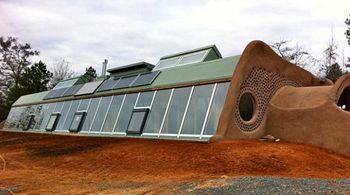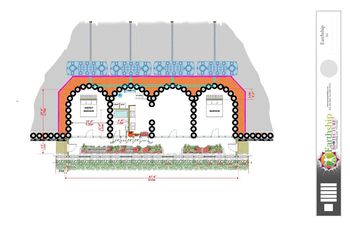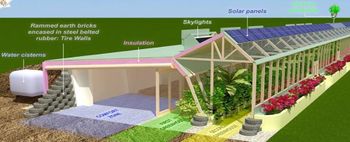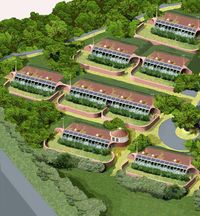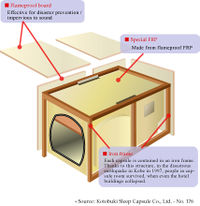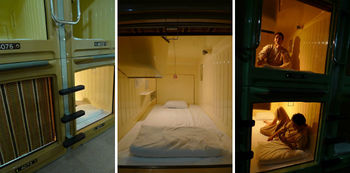Team:Dwellings
Activities: Research, design and document everything concerning where people live or sleep
This is the Wiki page for The RBE10K Project's Dwellings Team.
Contents |
Objectives
Document a variety of structures where people can sleep or live in. Must conform to the budget allocated, of $1500 maximum per person, including infrastructure, furniture and all features including recycling of waste, with the sole exception of energy and maybe water.
Earthship information
Two-story Earthships with Capsule Hotels
This proposal involves the construction of 5 Earthship buildings for the whole community to sleep. The buildings will be scaled-up versions of standard Earthships, with 2000 beds each. It is proposed that all buildings face the same optimal direction for maximum availability of a constant internal temperature all year round. The dimensions are approximated, and ranges are shown as a result of either flexibility to try different designs, or lack of clarity with regards to accurate measurements for Earthship construction.
The intention for this building is manyfold:
- Maximise comfort and conveniences from a minimal budget per person (15% of the contribution)
- Promote the transition to a mentality of access as opposed to ownership
- Promote community values and a very social environment
- Promote personal responsibility towards shared resources
- Promote respect for other's privacy and intimacy in shared environments
- Provide an environment akin to university campus dorms, promoting an academic lifestyle
Budget
Each building is intended to cost US$3m, with US$1.5m to be used for the building infrastructure, and the remainder distributed in 2000xUS$750 capsule-hotel units for bedding.
General Design
Each building is intended to be a standard long-shaped Earthship of 12 oversized sections, and a non-standard construction on top for showers, toilets, lounges, eateries and a kitchen. Each building will be placed facing north or south, according to the latitude, for a maximum of sunlight at the front of the building. Even though these buildings will be used mostly for sleeping during the night, the sunlight will be used for keeping a stable temperature throughout the year, and to cause a air-flow and ventilation. All buildings are located at short walking distance to the main central buildings.
The standard components of an Earthship include, from back to front, the chambers, a corridor from end to end joining all sections, an internal garden with edible plants and ponds that assist with purifying water, the front of the building's glass wall, and an external garden of specialised bushes that assist with the breaking-down and recycling of wastewater. The entries to the building are at the sides, and there may be another entry or two at the front.
Chambers and Capsule Beds
Each chamber must be a minimum of 6m wide, 40m long excluding the deep end's bow, and 4m high. Should sections not be capable of being as long as specified previously, more chambers can be added to compensate, in order to accommodate for the 2000 capsule beds. Chambers are exactly the same, except for the 2-4 chambers having stairs connecting with the upper level.
Chambers of 4m from floor to ceiling, 40m long excluding the bowed tip, and without stairs, can accommodate for 180 capsule beds each, i.e. 30 piles of 3 capsules high on each side, for a total of 90 130x130cm capsules per side. Each capsule has a hollow end meant to sit against one of the side walls, and its entry opening on the other end. Capsules are 2.50m long, causing a narrowing of the chambers by 5m. The corridor created between the capsules must be at least 1m, and can be up to 4m. A corridor of 3-4m could have lounges and small tables with 2-4 chairs throughout its length, for added comfort and socialising.
Chambers with stairs going up are similar to the other chambers, however with fewer capsules, as the stairs will occupy part of the front of the chamber. The stairs could have several shapes, and the placement of capsules on such chambers will be according to the shape of the stairs.
Capsule Bed Design
The capsules are currently proposed with a design as follows:
- A capsule size of 250cm length, 130cm width, and 130cm height.
- All the boxes will be housed indoors, in properly ventilated and air-conditioned large rooms with a steady temperature.
- The intended lifespan is as long-lasting as can be afforded, and balance quality and features.
- The structures could be either plastic, fiberglass or an alternative material, ideally flame-resistant and reinforced with metal bars for strength.
- Since units go against the wall they don't require a back wall; each unit is a hollow squared tube with a slightly rounded and narrowed entrance at the front.
- Only the front would be visible, so the outside material doesn't need to be neat, except for the visible front section.
- Allow for 110cm room from the top of the mattress to the capsule's ceiling.
- Include mattress based on Australia's standard for king-single mattress size, of 107x203cm.
- Walls are 5cm thick, reinforced with metal bars for structural strength.
- One of the internal sides has either a few moulded depressions to simulate a table and a number of shelves, or have mounted shelving.
- Could include a fold-up table, and/or a storage space
- Double-units for couples have the same height and twice the width, and an Australia's standard for king-size mattress, of 183x203cm.
- An alternative to consider for double-units are units 1.5x the width and height, with a mattress of 170cm width instead, and placed in groups of four; this would cause four couples (8 people) to use the space of 9 individuals, and therefore less efficient in terms of people density, but much more comfortable for couples.
- Unit weight should not be a problem since all modules will be held at ground level.
- Unit sizes can be determined first, and then considering adjustments needed for the design of the buildings to suit them accordingly.
- Since the buildings will be experimental, there would be a higher than normal risk of collapse, so units should have metal reinforcements for peace of mind.
- Since the Earthship's internal walls are very thick, so sound-proofing between rooms or at the back of a bed unit is necessary.
- Units are not lockable, and have either a cloth or roll-down curtain.
- The curtain will be mostly for privacy and marginal-proofing, and there will be no need to protect belongings since there will not be any valuables held in them.
- Inbuilt lighting in the module will be determined by cost for either inbuilt lighting or manual attachment of one on finished products.
- The lighting is based on low-powered LEDs, and ideally a 12V 30cmx30cm pane on the ceiling, at a cost of $29 each.
- The units have USB ports with 5V and 2A for connecting and charging devices.
- The inside holds a mattress, possibly the most important characteristic of the unit, and which can possibly be made to fit; a good mattress would be justified, like a memory foam mattress.
- Underneath the mattress there is a slightly springy (or at least capable of keeping air flow) rack, which can be either removable or part of the structure of the unit.
- The units are assembled by the people in the community themselves, maybe with the support of training for a leading assembling team to train others, which could possibly be done remotely via Skype.
Upper floor
The upper floor has a standard construction, placed on top of the Earthship. The material of choice to be used for the walls of this building may require considering a possible lack of suitable rigidity at the roof of the Earthship.
The building has toilets, wall urinals, showers and changing rooms at both sides, and towards the middle two lounges, then two dining places, and a kitchen in the middle. At each end there are two shower rooms, each with 12-20 showers and a changing section, one of them with also a urinal wall. Next to the showers there are 10-20 unisex toilets well enclosed and with some simple sound-proofing. Showers and toilets are separated from the toilets and showers by a wall with doors. The sizes of showers, lounges, diners and kitchen can be determined by the architect, and can be thought of being all of a similar size. The kitchen will be used mostly for beverages, snacks, and occasional personal or group breakfasts, meals or parties, i.e. there will be main comunal diners on separate buildings and this kitchen will only be used occasionally. The lounges would be used for watching films with projectors, reading, socialising, etc.
1000 beds version
The 1000 beds Earthship version is shorter and narrower. It has the following features:
- beds: 120 per corridor, 1080 per building
- surface: 80.5m x 34.55m (2781.275m² area)
- dorm corridors: 26m x 8m (9 of them)
- tires: 76.2cm diameter x 23.5cm height
- tire columns/walls: 85cm width (4.4cm adobe/plaster/light-concrete max width)
It requires the following quantities of material:
- 2350m² of glass: $55k (at $23.16 per m², see http://www.ecuador.generadordeprecios.info/obra_nueva/Fachadas/Vidrios/Templados/Luna_de_vidrio_templado.html)
- 150mm width concrete slabs for suspended floor (assuming 3000 people -80kg each- on it evenly distributed is 375kg/m² (3.6 kPa[1]), supported every 4m gives 150mm[2])
Google Sketchup designs (install Google Sketchup 2013 Make or Viewer to open the contents of these zipped files):
Earthship X1000
- Cement:
- 2.13 tons of cement = 1m³ of concrete
- 29 x Buttresses (4.3m x 0.3m x 0.7m + 0.5x[4.3m x 0.3m x 0.5m]): 0.903m³ + 0.323m³ = 1.226m³ reinforced concrete each = 35.54m³ total reinforced concrete = 75.7 tons of cement
- 29 x Buttress foundations (1m x 0.3m x 0.6m - 0.3m x 0.3m x 0.5m): 0.18m³ - 0.045m³ = 0.135m³ reinforced concrete each = 3.915m³ total reinforced concrete = 8.34 tons of cement
- 102 x Columns (4.3m x 0.3m x 0.3m): 0.387m³ reinforced concrete each = 39.5m³ total reinforced concrete = 84.2 tons of cement
- 85 x Column foundations (0.3m x 0.5m x 0.5m - 0.3m x 0.3m x 0.3m) = 0.075m³ - 0.027m³ = 0.048m³ each = 4.08m³ total reinforced concrete = 8.7 tons of cement
- Front foundation (78.8m x 0.7m x 0.6m - 17x[0.3m x 0.3m x 0.3m]): 33.1m³ - 0.46m³ = 32.64m³ total reinforced concrete = 70 tons of cement
- 38 x Wood column foundations (0.6m x 0.3m x 0.3m - 0.15m x 0.15m x 0.3m): 0.054m³ - 0.00675m³ = 0.0473m³ reinforced concrete each = 1.796m³ total reinforced concrete = 3.83 tons of cement
- Concrete slabs total area (79.71m x 25.31m x 0.15): 302.62m³ total reinforced concrete = 644.58 tons of cement
- Total cement: 75.7 + 8.34 + 84.2 + 8.7 + 70 + 3.83 + 644.58 = 895 tons x $60 p/ton = $53,700 / 900 people = $60 p/person
Capsule Hotel Quote Requests
Rencol
We requested a quote from Rencol on 11 May 2013 and on 14 May 2013 they advised us that they don't have the ability to produce what we requested.
Sleepbox
They produce sleepboxes, which are expensive luxury units for public spaces, either indoors or outdoors. However they pointed out that their manufacturers can create custom boxes for us. For more information and communications to date, see the main article.
External links
- Capsule hotels
- http://www.yesicanusechopsticks.com/capsule/
- http://www.yesicanusechopsticks.com/thesequel/capsule/
- http://japan-articles.japanican.com/en/articles/shinjuku_kuyakoshomae_capsule_hotel.html
- http://www.kotobuki-seat.com/company/history/ (Kotobuki invented and first developed the capsule hotels)
- Sleepbox
- Dome buildings
Members
Requests
Offers
References
- ↑ Convert kPa to ton/square metre: http://www.convertunits.com/from/kPa/to/ton/square+metre
- ↑ Guide to residential floors: http://www.concrete.net.au/publications/pdf/Res%20Floors%20Web.pdf
